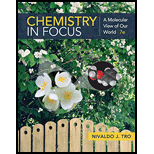
Concept explainers
A pond has a surface area of
Interpretation:
The surface area of the pond,
Concept Introduction:
Dimensional analysis is useful in converting one unit to another.
To convert a quantity
Answer to Problem 29E
Solution:
(a)
(b)
(c)
Explanation of Solution
a)
To convert
And
Thus, correct conversion factors will be
Multiply the conversion factors with the given quantity, cancelling units to get the desired quantity.
Hence,
b)
To convert
Thus, correct conversion factor will be
Multiply the conversion factor with the given quantity, cancelling units to get the desired quantity.
Hence,
c)
To convert
Thus, correct conversion factor will be
Multiply the conversion factor with the given quantity, cancelling units to get the desired quantity.
Hence,
Want to see more full solutions like this?
Chapter 2 Solutions
Chemistry In Focus
- What is density? Give two examples of possible units for density.arrow_forwardFor a material to float on the surface of water, the material must have a density less than that of water (1.0 g/mL) and must not react with the water or dissolve in it. A spherical ball has a radius of 0.50 cm and weighs 2.0 g. Will (his ball float or sink when placed in water? (Note: Volume of a sphere=43r3 .)arrow_forward1.47 A student weighs 10 quarters and finds that their total mass is 56.63 grams. What should she report as the average mass of quarter based on her data?arrow_forward
- Ethanol has a density of 0.789 g/cm3. What volume must be poured into a graduated cylinder to give 19.8 g of alcohol.arrow_forward1.78 Some farmers use ammonia, NH3, as a fertilizer. This ammonia is stored in liquid form. Use the participate perspective to show the transition from liquid ammonia to gaseous ammonia.arrow_forward1.30 The largest computers now include disk storage space measured in petabytes. How many bytes are in a petabyte? (Recall that in computer terminology, the prefix is only “close” to the value it designates in the metric system.)arrow_forward
- An aquarium has a rectangular cross section that is 47.8 in. by 12.5 in.; it is 19.5 in. high. How many U.S gallons does the aquarium contain? One U.S. gallon equals exactly 231 in3.arrow_forward1.48 A rock is placed on a balance and its mass is determined as 12.1 g. When the rock is then placed in a graduated cylinder that originally contains 11.3 mL of water, the new volume is roughly 17 rnL. How should the density of the rock be reported?arrow_forward

 Chemistry & Chemical ReactivityChemistryISBN:9781133949640Author:John C. Kotz, Paul M. Treichel, John Townsend, David TreichelPublisher:Cengage Learning
Chemistry & Chemical ReactivityChemistryISBN:9781133949640Author:John C. Kotz, Paul M. Treichel, John Townsend, David TreichelPublisher:Cengage Learning- Chemistry: Matter and ChangeChemistryISBN:9780078746376Author:Dinah Zike, Laurel Dingrando, Nicholas Hainen, Cheryl WistromPublisher:Glencoe/McGraw-Hill School Pub Co
 Introductory Chemistry: A FoundationChemistryISBN:9781285199030Author:Steven S. Zumdahl, Donald J. DeCostePublisher:Cengage Learning
Introductory Chemistry: A FoundationChemistryISBN:9781285199030Author:Steven S. Zumdahl, Donald J. DeCostePublisher:Cengage Learning Introductory Chemistry: A FoundationChemistryISBN:9781337399425Author:Steven S. Zumdahl, Donald J. DeCostePublisher:Cengage Learning
Introductory Chemistry: A FoundationChemistryISBN:9781337399425Author:Steven S. Zumdahl, Donald J. DeCostePublisher:Cengage Learning





